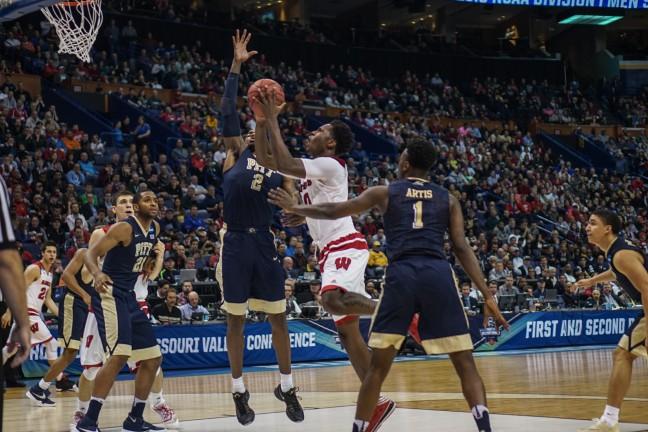In the final four games of his junior season, forward Nigel Hayes took a total of 54 shots — he made only 11.
That’s a grand total of about 20 percent shooting from the field in the four most important games of the season. It was win-or-go-home time for Hayes and the Badgers, and the first-team All-Big Ten performer was reluctant to show up.
After shooting 2-15, his worst shooting performance of the season, in the loss to Nebraska in the Big Ten Tournament, fellow juniors Vitto Brown and Bronson Koenig bailed out Hayes in the first two rounds of the NCAA Tournament, where he shot a combined 5-27.
In the Sweet 16 game against Notre Dame, Hayes did manage to put up his best performance of the four games — a measly 4-12, which included two three-pointers. But there was no one to bail him out, and the end of the season could not have gone worse for the junior.
But despite the poor performances and the criticisms that came as a result, Hayes is still testing the NBA waters, even if he is just dipping his feet in.
Last Tuesday, head coach Greg Gard announced they were going to submit Hayes’ name to the NBA advisory committee, and he will then make his decision regarding the NBA draft. This means that Hayes will submit his name for consideration and have the ability to rescind his name up to 10 days after the NBA Draft Combine May 15.
Given the way Hayes’ junior campaign ended, it’s more than likely he won’t garner much interest from NBA teams until maybe the end of the second round of the draft. But there is a reason this was initially thought to be Hayes’ final year at Wisconsin. There is a reason he was thought of a potential top-20 pick. There is a reason Hayes is even bothering to submit his name for consideration.
Hayes is a very talented basketball player whose skill set is made for today’s NBA.
After playing power forward for his first two seasons with the Badgers, Hayes made the move to small forward this season to make room for Brown and redshirt freshman Ethan Happ in the frontcourt. That move alone allowed Hayes to display his versatility on both sides of the ball and ultimately proved his ability to be viable two-way player at the next level.
Offensively
At 6 feet 8 inches tall, Hayes would be undersized as a power forward in the NBA, but an above-average height at small forward. These types of players are usually referred to as “tweeners,” as they are floating somewhere in between two positions.
These types of players are usually seen as risks at the next level, but the way Hayes showed his play on the wing as a small forward should have removed a lot of doubts in terms of what position he should be playing.
He’s a small forward, and when on the wing, Hayes is likely to be a mismatch for the defense on nearly every possession.
This was on display in Wisconsin’s final game of the season against Notre Dame, where the already undersized Fighting Irish had no choice but to give 6-foot-5-inch guard Steve Vasturia the assignment of defending Hayes. While Vasturia is the team’s best perimeter defender, three inches is a lot to give up to a player with Hayes’ strength and finishing ability.
Unfortunately, Hayes did not take advantage of this matchup, appearing reluctant to take Vasturia down to the block, where he has found the most success this season. But it won’t be the last time Hayes finds himself with that kind of matchup offensively, and it will only make it easier for him to both score and distribute.
Defensively
Hayes’ versatility also allows him to excel defensively, as his prowess on the defensive end never wavered even when the success rate of his jump shot did.
His ability to defend three different positions is intriguing enough, but his ability to be successful in doing so is what is most intriguing about the junior’s defensive prowess.
On the short list of players Hayes defended this season for extended stretches, are two national player of the year: Michigan State’s Denzel Valentine and Oklahoma’s Buddy Hield, along with Iowa’s Jarrod Uthoff, Indiana’s Troy Williams and Illinois’ Malcolm Hill.
That’s two shooting guards, two small forwards and power forward, and Hayes managed to defend all of them admirably.
His length combined with his lateral quickness for someone with his size is something that NBA teams will most definitely find valuable. But that said, it is still clear that Hayes is not yet ready to take the next step.
That doesn’t mean that he never will be.
He struggled in the final stretch, which may even be an understatement, but those struggles don’t take away Hayes’ potential. He may be one year away still, but there is no doubt he’ll be ready.


